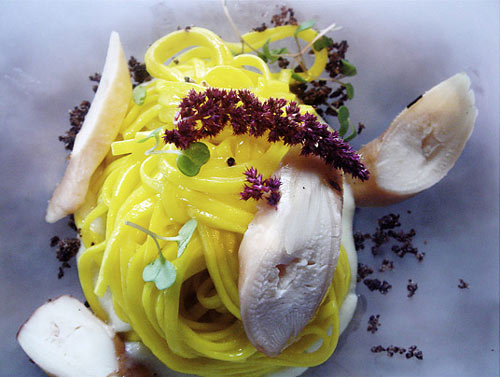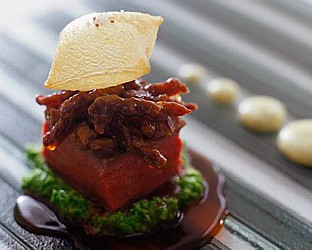You are hereBlogs / WcP.Art's blog / Taking best of international cuisine, Melbourne becomes world's latest destination for inventive, delicious food
Taking best of international cuisine, Melbourne becomes world's latest destination for inventive, delicious food

(quote)
Melbourne has become the world's latest destination for inventive, delicious cuisine. The term "foodie" is often heard in Melbourne, such a mecca for good eating, you could call it the Southern Hemisphere Paris. Certainly, securing a reservation at chef Shannon Bennett's Vue de monde can be as tough to get as a table for two at one of Joel Robuchon's establishments. Culinary creations by Bennett, 34, a native of Melbourne who looks more like a surfer than a super chef, include what he calls a "virtual gnocchi," a cep puree treated to an in-kitchen chemistry lesson which defines its shape, then served accompanied by sautéed king brown and shimeji mushrooms and zucchini flowers and finished with a tarragon emulsion. Another crowd pleaser is the bouillabaise which is presented at the table in a glass-toped, 1950s-style coffee percolator filled with aromatic shellfish stock. After this concoction is brought to a boil, it is poured into a bowl of tartares of crayfish and king fish cloaked in buffalo mozzarella.

Of course, many big cities these days have at least one restaurant which can challenge the best in the French capital, if not for stunning Belle Époque interiors, then certainly for surprising cuisine. However part of what makes Paris so unique is also the old-world charm of its eateries. Yet those too can be found in Melbourne, which, with its grand foundations in the 1850s Gold Rush, has a long history of fine French restaurants, their chefs being imported from France, and, from the 1920s onwards, robust Italian eateries where the chefs were émigrés, who stayed. The most bustling to this day is The Flo (which has no connection to the Paris brasserie chain), under whose Tuscan-inspired murals the likes of Lauren Bacall, Rock Hudson and Rudolf Nureyev have all dined. Today, the owner-chef is Guy Grossi, and Grossi Florentino, the Flo's proper name, also features a street-level outdoor cafe which opened in 1956 when Melbourne hosted the Olympic Games.

Ah, but what also makes Paris so delectable is constant reinvention. When the zinc bars become routine, there's always somewhere new to discover. Melbourne maintains a similar capacity for discovery, with a recent entry on the restaurant menu being Añada, opened by twenty-something husband and wife team, Jesse and Vanessa Gerner, (he's the chef, she runs front-of-house) in the funky Fitzroy neighborhood (Brooklyn's Williamsburg would be the New York equivalent). Locals are flocking here for tasty tapas plates such as white anchovies with hearts of palm or "raciones" (bigger plates) not only reminiscent of the Moorish tastes of Southern Spain, but also fulsome with the flavors of regional produce. Delicacies include slow-cooked South Western Highland pork belly doused with fennel seeds and smoky eggplant as well as Anson Bay clams from the nearby island state of Tasmania, brightened with La Goya Manzanilla and mint.

The rich culinary offering and heritage are due in part to the four seasons being much more distinct than, say, 550 miles to the north east in Sydney. Then there's the plethora of nature's bounty found within easy reach of a city surrounded by rich agricultural land and the sea. Produce for the world's cuisines is cultivated by passionate small growers, hence the city's bustling food markets. Although founded after Sydney, Melbourne was free-settled. (Think how that might have affected early expectations of what people put in their mouths).

While its wide boulevards, perfect for outdoor dining, are the legacy of its gold rush riches, Melbourne's varied palate comes from waves of immigration. The city has the biggest Greek population outside of Athens and, as for the Italians, mostly, they hail from a different generation to their "cousins" in America, many of them having left the turmoil of the cities of postwar Italy, (while in contrast, the majority of New York's 19th century Italian immigrants were the southern, rural poor). Thus Australia's Italian food, even as it arrived here, cut through the strict, regional divides of the home country, especially as those from the north wed those from the south, further mixing things up in the kitchen. Today's Melburnians are a melting pot of Celtic, Southern European, Middle European, Middle Eastern, and Asian heritage, and what links them is the food scene.

Grossi believes that what makes the food scene so vibrant is the mix. Referring to himself as "a Melburnian chef with an Italian heritage," he adds, "I don't turn my back on ingredients just because they are not traditional. We don't have to be shackled to old rules. We've got these beautiful ducks livers on the bench today and we're going to sauté them up and do a chestnut flavored pappardelle, which is not strictly Tuscan. People here are brave. You put tripe on the menu, they'll try it and while it may not be as popular as some other dishes, it's a little bit different for your loyal regulars. This restaurant has been here nearly 100 years. With Melbourne people, if you do the right thing, the clientele keeps coming. This isn't a city where the latest kid on the block gets all the attention."

Joseph Licciardi, who was born in Sicily and who runs Kin, muses that Melburnians "treasured the food traditions they arrived with and became adventurous - you had to be, years ago, to come all the way here." His own restaurant, in the Carlton neighborhood, is its own multi-cultural microcosm: his wife, Rosa, who was born in Puglia in the south of Italy, cooks alongside their Australian-born son, Enrico, while their daughter, Agatha, waits tables. "When our kids were growing up here, they would go for yum cha (Chinese dim sum) and try the duck feet," he explains. "And today Rosa cooks unagi eel from Japan, but we offer it in an Italian way." Thus, while a tagliatelle with sweet pumpkin glaze, balanced with aged balsamic vinegar, tastes exactly as it would in Modena, the flavors of the freshest fish, caught nearby, are brought out by serving them raw, in an Asian marinade. "It isn't about "fusion," it's about not limiting yourself to the old ways," says Licciardi.

Making the traditional fresh again has made a star of George Calombaris, 29, something of an Australian Gordon Ramsay. It has also inspired the Melbourne-born chef of Greek origins to open restaurants in his ancestral homeland, where, he says, "they have been serving fried stuff and dips and cheese to tourists on the islands although that's not what we eat at home." Calombaris helms The Press Club, the Maha Bar and Grill, and Hellenic Republic in Melbourne as well as The Belvedere Club on Mykonos.
Even children are welcome at most Melbourne restaurants. Formal places like the Press Club go to pains to point out that they will create child-sized portions of any dish. One Melbourne mother recalls the time she asked her twins as they were playing in the sandpit if they were making mud pies. "It's stuffed zucchini flowers," they replied.
(unquote)
Photos courtesy of Time, Mark Roper / Vogue, and lifestylefood.com.au
Original Source: Time
Related Articles: Anada has arrived and conquered, Hot in the city as top chefs spice up Melbourne food scene, and Melbourne’s top restaurants are lure for foodies at new festival



















Melbourne may be oft-overlooked when it comes to paying respect to the world's culinary capitals. Sydney usually steals the culinary thunder in Australia, but Oz's scrappy second city is not always outdone. There are numerous standout restaurants that have helped shaped Melbourne's burgeoning reputation as a food destination. After the jump, a list of a few Melbourne eateries where you truly can't go wrong.